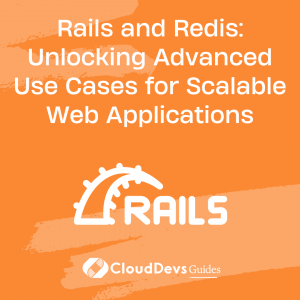Rails and Redis: Unlocking Advanced Use Cases for Scalable Web Applications
Table of Contents
Redis, an in-memory data structure store, has become a popular choice for developers looking to enhance the performance and scalability of their Ruby on Rails applications. By leveraging Redis, developers can tackle complex challenges such as caching, real-time data processing, background jobs, and more. In this blog post, we will explore advanced use cases of integrating Rails with Redis, showcasing how this powerful combination can take your web application to the next level.
1. Understanding Redis:
We begin by introducing Redis and its key-value store architecture. We delve into the benefits of using Redis as a caching layer, where frequently accessed data can be stored in memory, reducing the need for costly database queries. We also explore the features that make Redis an excellent choice for handling real-time data processing, pub/sub messaging, and data structures such as lists, sets, and sorted sets.
2. Caching with Redis:
Caching is a crucial technique for optimizing application performance. We explore how Rails integrates with Redis to implement caching at various levels, including fragment caching, page caching, and low-level caching. We demonstrate how to configure Rails to use Redis as a cache store and showcase best practices for cache invalidation and expiration strategies.
3. Real-Time Data Processing:
Redis’s pub/sub messaging mechanism makes it ideal for building real-time features in Rails applications. We explore the implementation of a real-time chat system using Redis pub/sub, allowing users to communicate instantaneously. We discuss the use of Redis streams for handling event sourcing and building scalable event-driven architectures.
4. Background Jobs and Task Queues:
Background processing is essential for offloading time-consuming tasks from the main request-response cycle. We explore how to integrate Redis with popular job queue frameworks like Sidekiq and Resque. We demonstrate how to define background jobs, enqueue them, and process them asynchronously using Redis as the backend. We also cover advanced features such as job prioritization, retries, and scheduling.
5. Rate Limiting and Throttling:
Redis’s atomic operations and data structures enable efficient rate limiting and throttling mechanisms in Rails applications. We discuss how to implement rate limiting for API endpoints or user actions using Redis’s sorted sets and counters. We explore strategies for enforcing rate limits and handling burst traffic to maintain application stability and prevent abuse.
6. Distributed Locking and Mutexes:
Coordination and synchronization of distributed systems can be challenging. We explore how Redis’s atomic operations can be leveraged to implement distributed locking and mutexes. We discuss scenarios where distributed locks are essential, such as preventing race conditions and ensuring data consistency across multiple servers or processes.
7. GeoSpatial Indexing and Location-Based Services:
Redis provides support for GeoSpatial indexing, making it a powerful tool for building location-based services in Rails applications. We explore how to store and query geospatial data in Redis, enabling features such as proximity search, location tracking, and geofencing. We showcase practical use cases and discuss optimization techniques for efficient geospatial queries.
8. Conclusion:
By combining the power of Redis with the flexibility of Ruby on Rails, developers can unlock advanced use cases and build highly performant and scalable web applications. We explored the advanced features of Redis, including caching, real-time data processing, background jobs, rate limiting, distributed locking, and geospatial indexing.
With Redis’s speed, simplicity, and versatility, developers can optimize application performance, handle large-scale data processing, and introduce real-time functionality. By leveraging Redis’s rich feature set, developers can overcome complex challenges and deliver exceptional user experiences. So, embrace Redis’s advanced use cases in Rails and elevate your web application’s performance and scalability to new heights.
